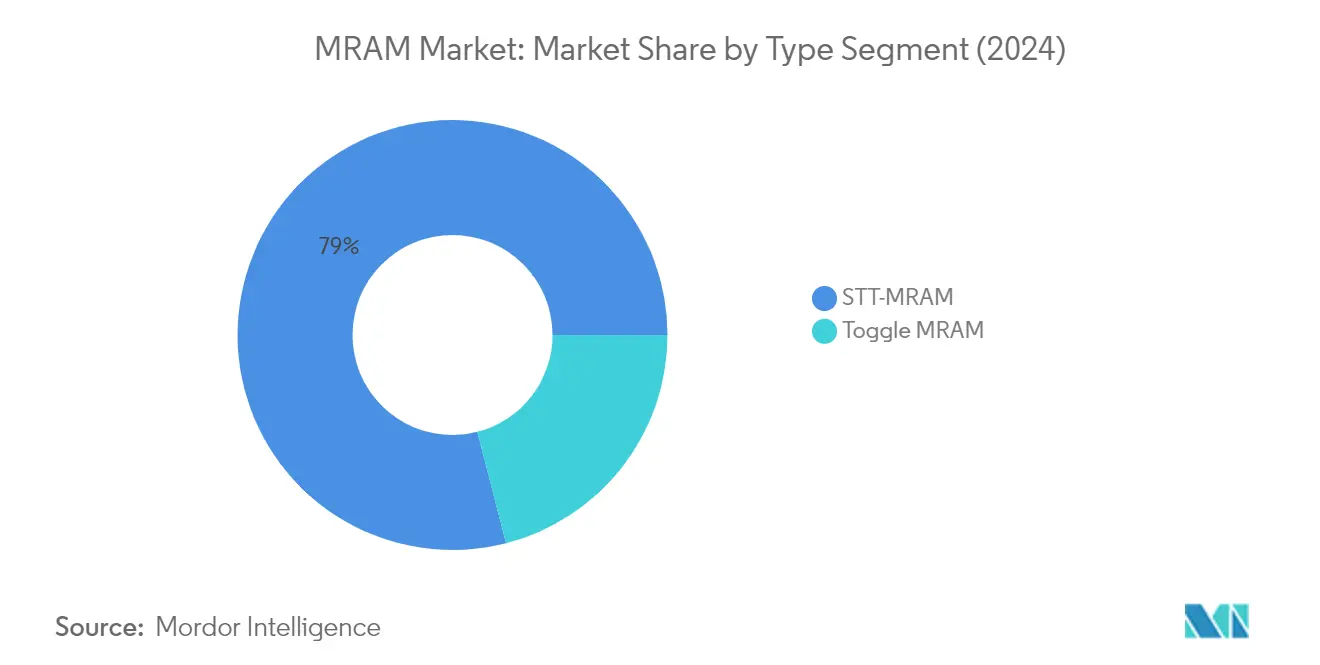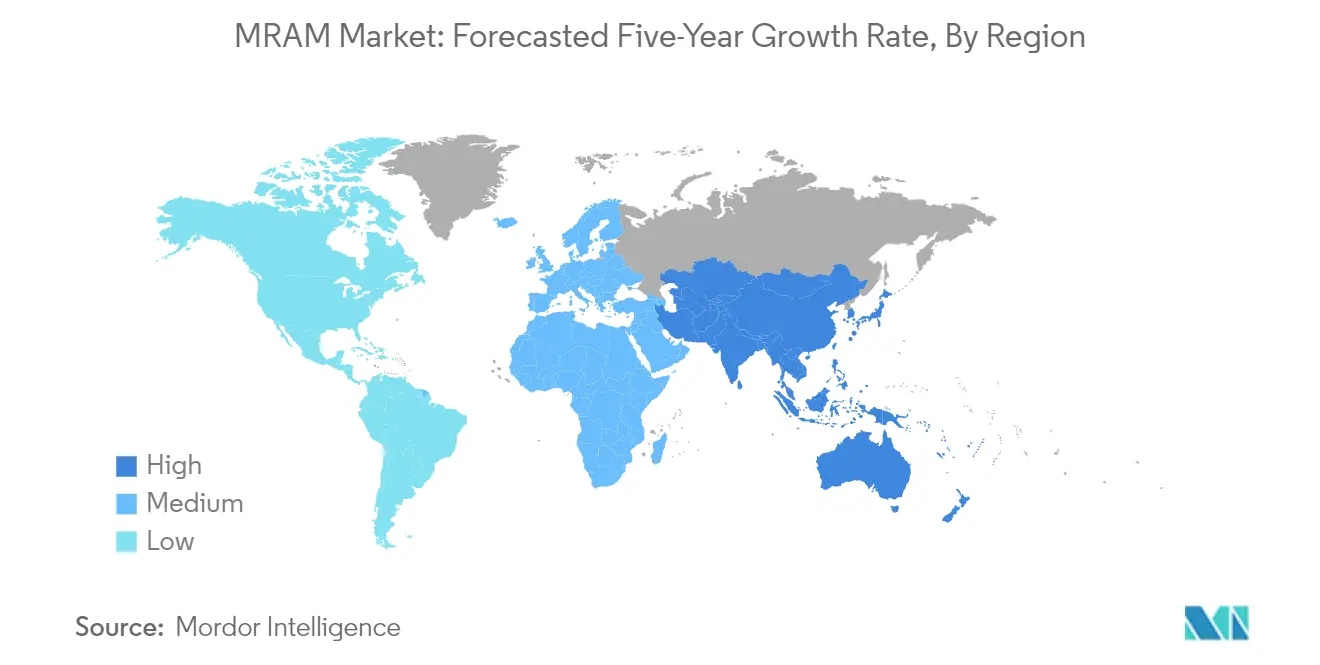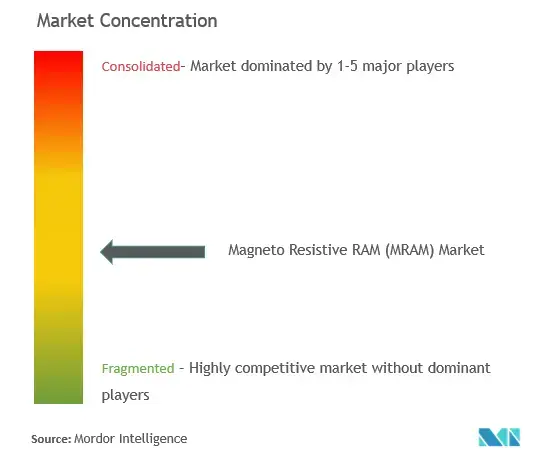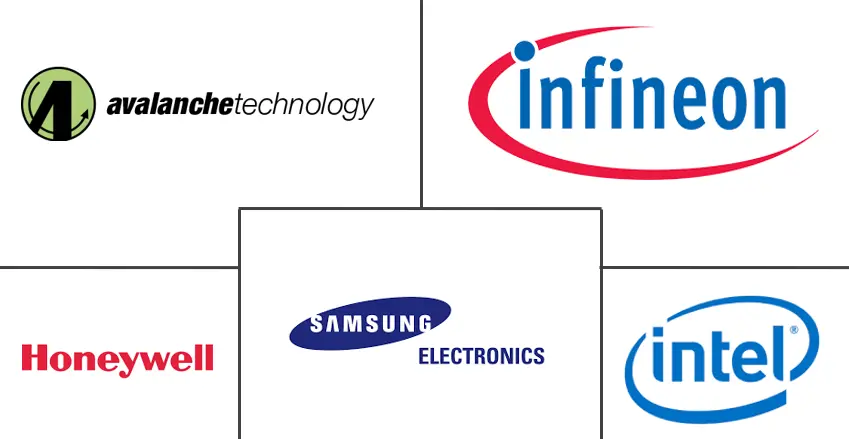MRAM Market Size and Share

MRAM Market Analysis by Mordor Intelligence
The MRAM Market size is estimated at USD 3.26 billion in 2025, and is expected to reach USD 36.49 billion by 2030, at a CAGR of 62.12% during the forecast period (2025-2030).
The MRAM industry is experiencing a transformative phase driven by technological advancements in spintronics and semiconductor memory manufacturing. Leading foundries are making significant strides in developing and commercializing advanced MRAM solutions, with Samsung's latest eMRAM technology achieving a remarkable 40% size reduction compared to traditional SRAM while maintaining competitive 30-50 nanosecond read and write speeds. This technological progression has enabled magnetoresistive random access memory to emerge as a viable alternative for conventional memory device solutions, particularly in applications requiring high performance and reliability. The convergence of MRAM with advanced manufacturing processes has opened new possibilities for integration in various electronic devices and systems.
The industry landscape is being reshaped by strategic partnerships and manufacturing innovations among key foundry players. Samsung, TSMC, and GlobalFoundries have scaled up their embedded MRAM solutions, with Samsung expanding its eMRAM applications to automotive, wearables, graphic memory, and edge artificial intelligence applications in 2024. These foundries are actively developing solutions at advanced nodes, with GlobalFoundries focusing on 12nm processes and TSMC offering 22nm eMRAM as an eFlash alternative. The manufacturing ecosystem's evolution has been crucial in addressing the growing demand for high-performance, energy-efficient semiconductor memory solutions.
The integration of MRAM with emerging technologies is creating new market opportunities across various sectors. According to Strategy Analytics, the number of connected devices is expected to reach 38.6 billion by 2025, driving demand for efficient, non-volatile memory device solutions in IoT applications. Magnetic memory's unique characteristics, including radiation tolerance, extreme temperature operation capability, and tamper resistance, make it particularly suitable for military and industrial applications. The technology's ability to combine the speed of SRAM with non-volatility has positioned it as a crucial component in next-generation computing architectures.
The enterprise storage sector is witnessing increased adoption of MRAM solutions, particularly in data center applications requiring high-speed cache and buffer operations. Intel's Non-volatile Memory Solutions Group reported a significant 46% year-over-year revenue growth, indicating strong market demand for advanced memory device solutions in enterprise storage applications. The technology's ability to provide protection against power loss without requiring supercapacitors or batteries has made it particularly attractive for critical data storage applications. Advanced memory technology's role in enabling faster data access and processing capabilities has become increasingly important as organizations seek to optimize their storage infrastructure for emerging workloads in AI, machine learning, and edge computing.
Global MRAM Market Trends and Insights
Increasing Demand for Miniaturization of Electronic Devices
Miniaturization in the electronic devices market has emerged as both a design and fabrication challenge, driving significant demand for advanced memory chip solutions like MRAM. The primary trend of end-product miniaturization has led both design and manufacturing professionals to develop products that are lighter, smaller, and less expensive while simultaneously being faster, more powerful, reliable, user-friendly, and functional. Portable electronic equipment has shown increasing requirements for smaller and thinner packaging systems for space optimization, particularly in highly integrated, high-speed applications like aerospace and certain consumer electronics segments. As a result, embedded memory packaging has become a central factor in electronic systems development, with active investments by packaging researchers working on embedded packaging and developing newer ways of embedding chips.
The continuous push for miniaturization has resulted in remarkable achievements in computing power density, where more processing capability is packed into ever-smaller footprints. This trend has led to increased transistor densities, decreased chip sizes, and proportional reductions in required board sizes for given devices. The advancement in materials technology, particularly in semiconductor polymers, has enabled a broader range of devices to be printed directly on surface layers. This capability has revolutionized the manufacturing process, allowing unique devices to be 3D printed alongside boards and conductors in a single process. Samsung's recent developments in eMRAM technology exemplify this trend, with their latest MRAM being 40% smaller than traditional SRAM while delivering 1,000 times faster performance than eFlash computer memory, demonstrating the significant strides made in miniaturization while maintaining or improving performance metrics.
Increased Use of MRAM in RFID Tags
The proliferation of edge computing across applications such as the Industrial Internet of Things (IIoT), wearables, artificial intelligence, automotive, robotics, medical devices, and portable designs has created an unprecedented demand for high-speed, low-latency, non-volatile, low-power, and cost-effective memory device solutions. MRAM has found significant applications in RFID tags, particularly in hospital environments where data loggers require multiple megabits of non-volatile memory to accommodate long-term data accumulation. These applications typically rely on battery power or energy harvesting, making MRAM's low-power characteristics particularly valuable. The technology's ability to retain data indefinitely in the event of power loss, combined with its unlimited endurance capabilities, makes it an ideal solution for data logging applications.
A groundbreaking initiative by Arm, known as Project Triffid, is exploring innovative applications of RFID tags for IoT implementations. The project aims to embed very low-power or even battery-less MCUs suited for IoT applications inside RFID tags, enabling them to not only capture and store information like conventional passive RFID but also process and act upon it. This development is particularly significant as it addresses the growing need for intelligent, autonomous devices in the IoT ecosystem, where projections indicate that 38.6 billion devices will be connected by 2025. The project's focus on developing circuits to detect irregularities, adaptive software, and non-volatile memory for data storage represents a significant advancement in RFID technology, potentially revolutionizing how MRAM is utilized in next-generation IoT memory applications.
Segment Analysis: By Type
STT-MRAM Segment in MRAM Market
Spin-transfer Torque MRAM (spin-transfer torque MRAM) has emerged as the dominant technology in the global magnetoresistive RAM market, commanding approximately 79% of the total market share in 2024. This technology combines the speed of SRAM with the non-volatility of flash while offering unlimited endurance, making it ideal for various applications from consumer electronics to enterprise storage. STT-MRAM has lower switching energy compared to Toggle MRAM and can reach higher densities, higher endurance, and faster write times. The technology's ability to scale well below 10nm while challenging the low cost of flash memory has made it particularly attractive for next-generation persistent memory applications. Major foundries, including Samsung, TSMC, and GlobalFoundries, have been actively developing and commercializing STT-MRAM solutions, particularly focusing on embedded applications for automotive, IoT, and edge computing sectors.

Toggle MRAM Segment in MRAM Market
Toggle MRAM represents the first generation of magnetic RAM technology, utilizing magnetic field changes to program/write bits. While this technology offers simplicity in development, it faces scaling challenges compared to its STT-MRAM counterpart. Toggle MRAM continues to serve specific applications where its unique characteristics provide advantages, particularly in replacing SRAM battery combinations in systems requiring data maintenance during power loss. The technology has found its niche in applications exposed to significant radiation, especially in satellites and aerospace systems, where its radiation tolerance and reliability make it an ideal choice. Toggle MRAM's ability to hold data for extended periods at temperatures ranging from -40°C to 150°C has maintained its relevance in specialized industrial and military applications.
Segment Analysis: By Offering
Embedded Segment in MRAM Market
The embedded memory segment has emerged as the dominant force in the global MRAM market, commanding approximately 76% of the total market share in 2024. This segment's leadership position is driven by the increasing adoption of embedded memory solutions across various applications, particularly in IoT devices, automotive systems, and edge AI applications. Major foundries, including Samsung, TSMC, and GlobalFoundries, have been scaling up their embedded MRAM solutions, with many offering advanced nodes at 28nm/22nm processes. The technology's ability to replace embedded flash (eFlash) in devices built using advanced manufacturing technologies has been a key factor in its market dominance. Furthermore, the segment is experiencing remarkable growth with a projected growth rate of around 82% from 2024 to 2029, driven by the technology's advantages such as fast read/write times, high endurance, and its potential to replace both embedded NOR and SRAM in SoCs.
Stand-alone Segment in MRAM Market
The stand-alone MRAM segment holds the remaining market share in the global MRAM market, primarily serving applications such as NVMe SSDs, NVDIMMs, and mobile applications. This segment's growth is primarily driven by low-density STT-MRAM devices manufactured by key players in the industry. The technology's inherent advantages, such as the ability to prevent data corruption without battery or capacitor backup and very low latency characteristics, make it particularly suitable for enterprise storage applications. However, the segment faces certain challenges as MRAM's inability to match DRAM on cost or density, and competition from NOR in the lower capacity range (256MB and below) has impacted its market penetration.
Segment Analysis: By Application
Enterprise Storage Segment in MRAM Market
Enterprise Storage represents the largest segment in the global MRAM market, commanding approximately 42% of the total market share in 2024. This dominant position is driven by the increasing adoption of MRAM in high-speed enterprise storage caches, where its unique combination of write endurance, data retention, and DRAM-like low latency access makes it ideal for holding critical cached data. The segment's growth is further fueled by demanding workloads in artificial intelligence, big data analytics, virtualization, and high-performance computing applications. Major technology companies are actively developing MRAM solutions specifically designed for infrastructure and data center providers to enhance system reliability and performance, particularly in scenarios where high-performance persistent memory is critical.
Consumer Electronics Segment in MRAM Market
The Consumer Electronics segment is emerging as the fastest-growing application area in the MRAM market, with projections indicating robust growth between 2024 and 2029. This exceptional growth is driven by technological advancements, increasing penetration of Internet of Things devices, emergence of 5G technologies, and continuous innovation in various devices to enhance memory capacity and power efficiency. The segment's expansion is particularly notable in smartphones, laptops, smart wearables, and digital cameras, where MRAM's combination of persistence, low power consumption, high speed, and high endurance makes it an ideal choice for next-generation devices. The increasing focus on developing flexible and wearable electronics is further accelerating the adoption of MRAM, as it outperforms traditional NAND memory in terms of data retention capacity after power cut-off and processing speed.
Remaining Segments in MRAM Market Applications
The MRAM market encompasses several other significant application segments, including automotive memory, robotics, aerospace and defense, and other applications. The automotive segment is gaining traction due to MRAM's ability to operate in extreme temperature conditions and its applications in engine control units, advanced transmission control, and in-car entertainment systems. The robotics segment utilizes MRAM for controlling codes, configuring files, and settings in industrial automation applications. The aerospace and defense segment leverages MRAM's radiation-tolerant properties and high-temperature data storage capabilities for critical applications. Other applications include energy and power, healthcare, agricultural, and retail sectors, where MRAM's unique characteristics enable various innovative solutions.
MRAM Market Geography Segment Analysis
MRAM Market in North America
North America represents a significant market for MRAM technology, holding approximately 26% of the global market share in 2024. The region's dominance is driven by its robust semiconductor memory market infrastructure and the strong presence of key technology companies. The market is particularly strong in the enterprise storage market, automotive applications, and consumer electronics sectors. The presence of major research institutions and technological innovation centers continues to drive advancements in MRAM technology. The region's focus on developing next-generation memory solutions for data centers, artificial intelligence, and IoT applications further strengthens its market position. Additionally, the increasing adoption of MRAM in military and aerospace applications, particularly in radiation-hardened environments, contributes to market growth. The strong intellectual property framework and continuous investment in R&D activities further cement North America's position as a key MRAM market.

MRAM Market in Europe
The European MRAM market has demonstrated remarkable growth, achieving approximately 101% CAGR from 2019 to 2024. The region's market is characterized by strong research and development initiatives, particularly in countries like Germany and France. European semiconductor manufacturers have been actively developing advanced MRAM solutions for automotive applications, industrial automation, and IoT devices. The region's strong automotive sector serves as a key driver for MRAM adoption, particularly in electric vehicles and advanced driver assistance systems. The presence of world-class research institutions and collaboration between academia and industry players has fostered innovation in MRAM technology. European companies have been particularly focused on developing energy-efficient MRAM solutions aligned with the region's sustainability goals. The market also benefits from strong government support and funding for semiconductor research and development initiatives.
MRAM Market in Asia-Pacific
The Asia-Pacific MRAM market is positioned for exceptional growth, with an anticipated CAGR of approximately 64% during 2024-2029. The region's market dynamics are shaped by its dominant position in global electronics manufacturing and memory chip market production. Countries like China, South Korea, and Taiwan are leading the charge in MRAM technology adoption and development. The region's robust electronics manufacturing ecosystem provides a strong foundation for MRAM integration in various applications. The presence of major semiconductor foundries and their increasing focus on MRAM production capabilities strengthens the market outlook. The growing demand for smartphones, wearables, and IoT devices in the region creates substantial opportunities for MRAM deployment. Additionally, increasing investments in artificial intelligence and edge computing applications further drive market expansion in the region.
MRAM Market in Latin America
The Latin American MRAM market is emerging as a promising growth region, driven by increasing digitalization and industrial modernization efforts. The region's market is characterized by growing adoption in automotive electronics and industrial automation applications. Countries like Brazil and Mexico are leading the regional adoption of MRAM technology, particularly in the manufacturing and telecommunications sectors. The increasing focus on developing smart manufacturing capabilities and Industry 4.0 initiatives creates new opportunities for MRAM deployment. The region's growing consumer electronics market and increasing smartphone penetration also contribute to market growth. Additionally, the expansion of data center infrastructure and cloud computing services in the region drives demand for advanced memory solutions like MRAM. The market also benefits from increasing investments in telecommunications infrastructure and 5G network deployment.
MRAM Market in Middle East & Africa
The Middle East and Africa MRAM market is witnessing steady growth, driven by increasing investments in digital infrastructure and industrial automation. The region's market is particularly strong in the Gulf Cooperation Council countries, where smart city initiatives and industrial modernization projects create demand for advanced memory solutions. The growing focus on developing local semiconductor capabilities and electronics manufacturing contributes to market expansion. The region's automotive sector, particularly in countries like the UAE and Saudi Arabia, presents opportunities for MRAM adoption in vehicle electronics. The increasing adoption of IoT devices and smart manufacturing solutions in industrial applications drives market growth. The region's focus on diversifying economies away from oil dependency through technology adoption creates favorable conditions for MRAM market development. Additionally, the growing investments in telecommunications infrastructure and data centers support market expansion.
Competitive Landscape
Top Companies in MRAM Market
The MRAM market features established semiconductor giants alongside specialized semiconductor memory technology providers, with companies like Samsung, Intel, Qualcomm, and Everspin Technologies leading innovation. These market leaders are actively investing in research and development to enhance their MRAM product portfolios, particularly focusing on embedded MRAM solutions and standalone devices. Companies are forming strategic partnerships with foundry service providers to strengthen manufacturing capabilities and accelerate the commercialization of new technologies. Product innovation is centered around developing high-density MRAM solutions, improving power efficiency, and enhancing data retention capabilities. Operational strategies include establishing dedicated production lines, investing in advanced manufacturing processes, and expanding global distribution networks. Market expansion efforts are primarily focused on targeting emerging applications in automotive, IoT, aerospace, and enterprise storage sectors, while strategic collaborations with research institutions and technology partners are driving technological advancement.
Consolidated Market with Strong Growth Potential
The MRAM market structure is characterized by a mix of large semiconductor conglomerates and specialized memory technology providers, with global players dominating the landscape. Major semiconductor companies leverage their extensive manufacturing capabilities and established distribution networks to maintain market leadership, while specialized providers focus on developing innovative magnetic memory solutions for specific applications. The market shows moderate consolidation, with key players actively pursuing vertical integration strategies to strengthen their position across the value chain. Strategic partnerships and licensing agreements between IP providers, foundry services, and equipment manufacturers are becoming increasingly common, creating a complex ecosystem of interdependent stakeholders.
The market demonstrates active merger and acquisition activity, particularly focused on acquiring specialized MRAM technology providers and intellectual property. Large semiconductor companies are strategically acquiring smaller, innovative firms to expand their MRAM capabilities and accelerate market entry. Collaboration between research institutions, technology providers, and manufacturing partners is driving industry consolidation, while joint development agreements between major players are becoming increasingly common to share development costs and reduce time-to-market for new products.
Innovation and Partnerships Drive Market Success
Success in the MRAM market requires a multi-faceted approach combining technological innovation, strategic partnerships, and market positioning. Incumbent players must focus on continuous product innovation, particularly in areas such as power efficiency, density improvements, and cost reduction, while maintaining strong relationships with foundry partners and equipment manufacturers. Establishing robust intellectual property portfolios and developing customized solutions for specific applications are crucial for maintaining a competitive advantage. Companies must also invest in expanding their manufacturing capabilities and distribution networks while fostering relationships with key customers in high-growth sectors.
For new entrants and contenders, success depends on identifying and targeting specific market niches where they can differentiate themselves through specialized solutions or superior advanced memory technology. Building strategic partnerships with established players, particularly in manufacturing and distribution, is essential for gaining market access. Companies must carefully navigate the high entry barriers, including significant capital requirements and intellectual property considerations, while being prepared for potential regulatory changes affecting semiconductor manufacturing and trade. The risk of substitution from emerging memory technologies necessitates continuous innovation and clear value proposition development, while high customer concentration in certain segments requires strong relationship management and customized solution development.
MRAM Industry Leaders
-
Honeywell International Inc.
-
Infineon Technologies AG
-
Intel Corporation
-
Avalanche Technology Inc.
-
Samsung Electronics Co. Ltd
- *Disclaimer: Major Players sorted in no particular order

Recent Industry Developments
- September 2022 - Avalanche Technology, a next-generation MRAM technology provider, and United Microelectronics Corporation (UMC), a semiconductor foundry, launched their new high-reliability Persistent SRAM (P-SRAM) memory devices through UMC's 22nm process technology. The memory device would be based on Avalanche Technology's latest generation of Spin Transfer Torque Magneto-resistive RAM (STT-MRAM) technology and would offer its customers significant density, reliability, endurance, and power benefits over the existing non-volatile solutions.
- July 2021 - Researchers at IIT Delhi (Centre for Applied Research in Electronics (CARE)) collaborated with the National University of Singapore (NUS) to achieve higher integration density in SOT-MRAMs (spin-orbit torque magneto-resistive RAM). According to researchers, SOT-MRAMs are better than STT-MRAM in terms of reliability and writing speed but not in high integration density.
Global MRAM Market Report Scope
Magneto resistive RAM (MRAM) is a non-volatile method of storing data bits in random-access memory using magnetic states instead of electrical charges, which is different from dynamic random-access memory (DRAM) and static random-access memory (SRAM), as they maintain data only until the power is applied.
The magneto resistive RAM (MRAM) market is segmented by type (toggle MRAM and spin-transfer torque MRAM), application (consumer electronics, robotics, automotive, enterprise storage, and aerospace and defense), and geography.
| Toggle MRAM |
| Spin-transfer Torque MRAM |
| Stand-alone |
| Embedded |
| Consumer Electronics |
| Robotics |
| Enterprise Storage |
| Automotive |
| Aerospace and Defense |
| Other Applications |
| North America |
| Europe |
| Asia-Pacific |
| Latin America |
| Middle-East and Africa |
| Type | Toggle MRAM |
| Spin-transfer Torque MRAM | |
| Offering | Stand-alone |
| Embedded | |
| Application | Consumer Electronics |
| Robotics | |
| Enterprise Storage | |
| Automotive | |
| Aerospace and Defense | |
| Other Applications | |
| Geography | North America |
| Europe | |
| Asia-Pacific | |
| Latin America | |
| Middle-East and Africa |
Key Questions Answered in the Report
How big is the MRAM Market?
The MRAM Market size is expected to reach USD 3.26 billion in 2025 and grow at a CAGR of 62.12% to reach USD 36.49 billion by 2030.
What is the current MRAM Market size?
In 2025, the MRAM Market size is expected to reach USD 3.26 billion.
Who are the key players in MRAM Market?
Honeywell International Inc., Infineon Technologies AG, Intel Corporation, Avalanche Technology Inc. and Samsung Electronics Co. Ltd are the major companies operating in the MRAM Market.
Which is the fastest growing region in MRAM Market?
Asia Pacific is estimated to grow at the highest CAGR over the forecast period (2025-2030).
Which region has the biggest share in MRAM Market?
In 2025, the North America accounts for the largest market share in MRAM Market.
What years does this MRAM Market cover, and what was the market size in 2024?
In 2024, the MRAM Market size was estimated at USD 1.23 billion. The report covers the MRAM Market historical market size for years: 2019, 2020, 2021, 2022, 2023 and 2024. The report also forecasts the MRAM Market size for years: 2025, 2026, 2027, 2028, 2029 and 2030.
Page last updated on:



